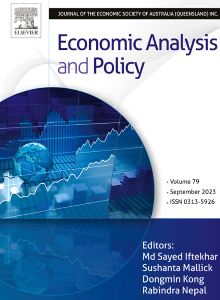Tapping the potential of green finance: Can energy efficiency credit drive traditional industries to green? Evidence from China
IF 8.7
2区 经济学
Q1 ECONOMICS
引用次数: 0
Abstract
In the context of accelerated global green transformation, green finance is emerging as a vital instrument for promoting sustainable development. However, traditional green financial instruments characterized by credit constraints often prevent energy-intensive industries from obtaining sufficient green financial support, making it challenging for them to undertake green transformation. How best to facilitate the green transformation of traditional high-energy-consuming industries remains a pressing challenge. To overcome the limitations of traditional green finance tools, China implemented the Energy Efficiency Credit Policy (EECP) in 2015. Distinguished from traditional green financial instruments dominated by credit constraints, EECP is designed to facilitate the green transition of high-energy-consuming industries by providing credit funding support. Taking EECP as a quasi-natural experiment, we systematically investigate how green financial instruments stimulate green innovation vitality in key energy-consuming industries by exploiting a difference-in-differences (DID) model. This effect is particularly evident in enterprises facing higher financing constraints, greater industry financing dependence, superior information disclosure quality, and more efficient information transmission. Further mechanism tests reveal that expanding long-term financing scales, reducing credit financing costs, and enhancing commercial credit financing are crucial channels through which the policy exerts its effects. Moreover, EECP can guide firms in optimizing internal resources allocation and encourage them to prioritize preventive green investments. Ultimately, EECP can improve the total factor productivity of target enterprises, facilitating their transformation and upgrading. Collectively, our findings underscore the indispensable role of green finance in advancing the green and low-carbon transition of traditional sectors.
挖掘绿色金融潜力:节能信贷能否带动传统产业走向绿色?来自中国的证据
在全球绿色转型加快的背景下,绿色金融正在成为促进可持续发展的重要工具。然而,以信贷约束为特征的传统绿色金融工具往往阻碍能源密集型产业获得足够的绿色金融支持,使其难以进行绿色转型。如何更好地促进传统高耗能产业的绿色转型仍然是一个紧迫的挑战。为克服传统绿色金融工具的局限性,中国于2015年实施了能效信贷政策(EECP)。与传统的以信贷约束为主导的绿色金融工具不同,EECP旨在通过提供信贷资金支持,促进高耗能行业的绿色转型。本文以EECP为准自然实验,运用差分中的差分(DID)模型,系统考察了绿色金融工具如何激发重点耗能行业的绿色创新活力。这种效应在融资约束程度较高、行业融资依赖程度较高、信息披露质量较好、信息传递效率较高的企业中表现得尤为明显。进一步的机制检验表明,扩大长期融资规模、降低信贷融资成本、增强商业信贷融资是政策发挥作用的重要渠道。EECP可以引导企业优化内部资源配置,鼓励企业优先进行预防性绿色投资。最终,EECP可以提高目标企业的全要素生产率,促进企业转型升级。总的来说,我们的研究结果强调了绿色金融在推动传统行业绿色低碳转型中不可或缺的作用。
本文章由计算机程序翻译,如有差异,请以英文原文为准。
求助全文
约1分钟内获得全文
求助全文
来源期刊

Economic Analysis and Policy
ECONOMICS-
CiteScore
9.80
自引率
9.20%
发文量
231
审稿时长
93 days
期刊介绍:
Economic Analysis and Policy (established 1970) publishes articles from all branches of economics with a particular focus on research, theoretical and applied, which has strong policy relevance. The journal also publishes survey articles and empirical replications on key policy issues. Authors are expected to highlight the main insights in a non-technical introduction and in the conclusion.
 求助内容:
求助内容: 应助结果提醒方式:
应助结果提醒方式:


